Text this colour links to Pages. Text this colour links to Family Trees. Text this colour are links that are disabled for Guests.
Place the mouse over images to see a larger image. Click on paintings to see the painter's Biography Page. Mouse over links for a preview. Move the mouse off the painting or link to close the popup.
Early Medieval Period is in Church Monument Periods.
Early Medieval Period monument to Sir John de Thornhill c.1260-1322. The face appears to have been replaced at sometime. Church of St Michael and All Angels, Thornhill [Map]
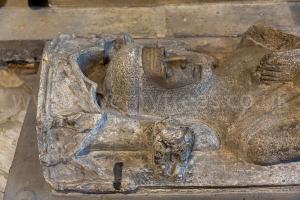
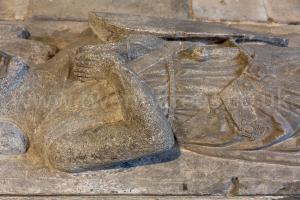
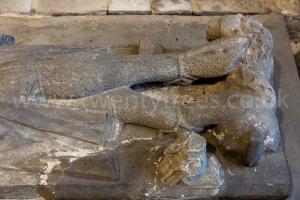
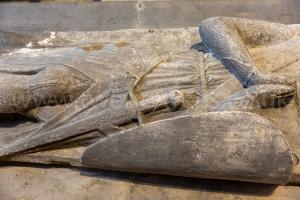
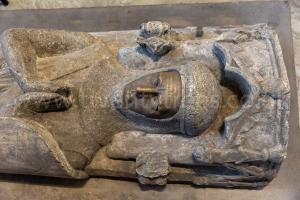
Before 1260 . The Early Medieval Period Period describes knights wearing a single piece of Chain Mail that covered the head, torso, arms and legs to the knees. Commonly associated with Crusader knights. There are theories crossed-legs mean the knight had been on Crusade, the number of times described by whether the legs are crossed at the ankles, the calves or the knees. None of these theories appear consistent with the extant examples. There are further theories about whether the meaning of Crossed Legs being crossed Right Leg over Left or vice-verse. These, also, do not appear consistent with extant examples.
After 1262. St Mary's Church, Boyton [Map]. Monument to Alexander Giffard. Believed to represent Alexander Giffard; possibly his father Hugh Giffard. Early Medieval Period effigy. Alexander fought on the Seventh Crusade and may possibly have died at the Battle of Mansoura in 1250. The effigy notable for the Otter at his feet, biting his sword, and for the  Giffard Arms on the shield with a label five points indicating the son, possibly grandson, of the current owner of the arms. The Otter may actually be a badly carved lion! Right Leg over Left.
Giffard Arms on the shield with a label five points indicating the son, possibly grandson, of the current owner of the arms. The Otter may actually be a badly carved lion! Right Leg over Left.
Hugh Giffard: Around 1195 he was born to Walter Giffard at Warminster, Wiltshire [Map]. Before 18th March 1217 Hugh Giffard and Sibyl Cormeilles were married. Around 1246 Hugh Giffard died at Warminster, Wiltshire [Map].






After 17th June 1282 William "The Younger" Valence was buried at Dorchester Abbey, Oxfordshire [Map]. His. Monument Early Medieval Period with Right Leg over Left. A particularly fine effigy with some remnants of its original colouring.
William "The Younger" Valence: he was born to William de Valence 1st Earl Pembroke and Joan Munchensi Countess Pembroke.



Monument to an unknown knight. Early Medieval Period. Church of St Mary Magdalen, Castle Ashby [Map].




Around 1300. Salisbury Cathedral [Map]. Monument to Unknown Knight. Early Medieval Period. Right Leg over Left. Formerly thought to be of William Longespée - see Effigy of William Longespee The Younger.
Around 1325. Monument to an unknown member of the de Vere Family in St Michael & All Angels Church, Great Tew [Map] notable for the armour having Aillettes. Right Leg over Left. Early Medieval Period.


After 1338. Howden Minster [Map]. Monument to Peter Saltmarsh (deceased). Early Medieval Period. Right Leg over Left.
Peter Saltmarsh: In 1280 he was born. In 1338 he died.
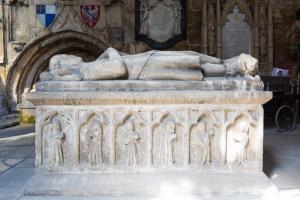
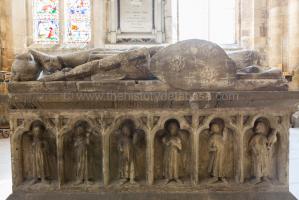
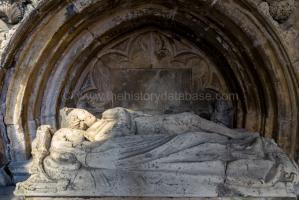
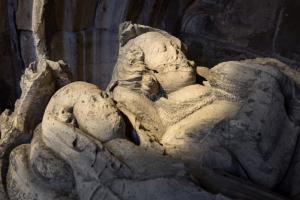
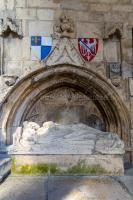
On 9th June 1360 Gerard Lisle 1st Baron Lisle (age 56) died at Stowe, Northamptonshire. His son Warin (age 30) succeeded 2nd Baron Lisle of Kingston Lisle in Oxfordshire. Margaret Pipard Baroness Lisle (age 37) by marriage Baroness Lisle of Kingston Lisle in Oxfordshire.
He was buried at St Michael's Church, Stowe Nine Churches [Map]. His effigy is of the Early Medieval Period with right leg over left.
Warin Lisle 2nd Baron Lisle: Around 1330 he was born to Gerard Lisle 1st Baron Lisle and Eleanor Fitzalan at Kingston Lisle, Oxfordshire. Before 1360 Warin Lisle 2nd Baron Lisle and Margaret Pipard Baroness Lisle were married. After 1360 Warin Lisle 2nd Baron Lisle and Joan Unknown Baroness Lisle were married. She by marriage Baroness Lisle of Kingston Lisle in Oxfordshire. On 28th June 1382 Warin Lisle 2nd Baron Lisle died. His daughter Margaret succeeded 3rd Baroness Lisle of Kingston Lisle in Oxfordshire.
Margaret Pipard Baroness Lisle: Around 1323 she was born to William Pipard. On 3rd August 1373 she died.



After 1366. Church of St Helen and the Holy Cross Sheriff Hutton [Map]. Monument to Edmund Thweng. Early Medieval Period. Right Leg over Left.
Edmund Thweng: In 1366 Edmund Thweng was killed.


Before 1400. St Barnabas Church, Stock Gaylard [Map]. Effigy of Ingelramus de Waleys. Early Medieval Period. When the tomb was opened a chamber measuring 4' x 1'6 by 1' was found beneath the effigy. The chamber contained a dismembered skeleton and fragments of red leather believed to be the bag in which Ingelramus' bones were brought back from the Holy Land for burial. Right Leg over Left.
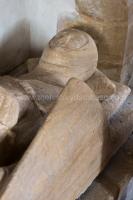
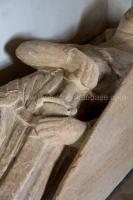
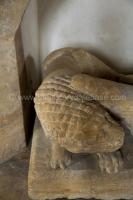
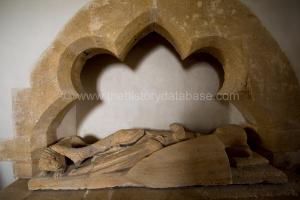
Effigy of an Unknown Knight in St Dubricius Church, Porlock [Map]. Early Medieval Period. Right Leg over Left.

